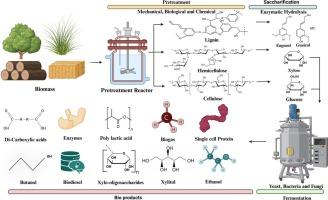木质纤维素生物质向可持续生物精炼厂增值的预处理技术:全面的见解和进展
Q1 Environmental Science
引用次数: 0
摘要
木质纤维素生物质(LCB)是燃料和其他产品的可持续原料,但由于其顽固性结构,生物转化具有挑战性。预处理为LCB分解成其组成聚合物(纤维素、半纤维素和木质素)提供了有效的解决方案。这些聚合物可以进一步转化为燃料和其他工业产品。然而,传统的预处理技术(物理、物理化学、化学和生物)要么不能有效地将LCB分离成完整的组分,要么其工业规模应用具有挑战性。与已有的文献不同,本研究不仅讨论了传统的预处理策略,还全面介绍了新兴的预处理技术(离子液体和深度共晶溶剂)、化学机理和工业挑战。此外,本研究还强调了技术经济分析的整合,以分析预处理方法的工业可行性,以及利用新兴计算工具(如人工智能和机器学习)开发可持续和经济的基于lcb的生物制品生物炼制的策略。本文章由计算机程序翻译,如有差异,请以英文原文为准。

Pretreatment technologies for valorisation of lignocellulosic biomass towards sustainable biorefineries: Comprehensive insights and advances
Lignocellulosic biomass (LCB) is a sustainable feedstock for fuels and other products, however bioconversion is challenging due to its recalcitrant structure. Pretreatment offers an effective solution for fractionating LCB into their constituent polymers (cellulose, hemicellulose, and lignin). These polymers can be further converted into fuels and other industrial products. However, conventional pretreatment techniques (physical, physicochemical, chemical and biological) either fails to efficiently fractionate LCB into intact components or their industrial scale application is challenging. Unlike existing reviews, this study not only discusses conventional pretreatment strategies, but also it comprehensively highlights emerging pretreatment technologies (using ionic liquids and deep eutectic solvent), their chemical mechanism and industrial challenges. Additionally, this study also highlights the integration of technoeconomic analysis for analysing industrial feasibility of pretreatment methods, and the strategies for utilisation of emerging computational tools such as Artificial Intelligence and Machine learning for development of sustainable and economic LCB-based biorefinery for bioproducts.
求助全文
通过发布文献求助,成功后即可免费获取论文全文。
去求助
来源期刊

Bioresource Technology Reports
Environmental Science-Environmental Engineering
CiteScore
7.20
自引率
0.00%
发文量
390
审稿时长
28 days
 求助内容:
求助内容: 应助结果提醒方式:
应助结果提醒方式:


